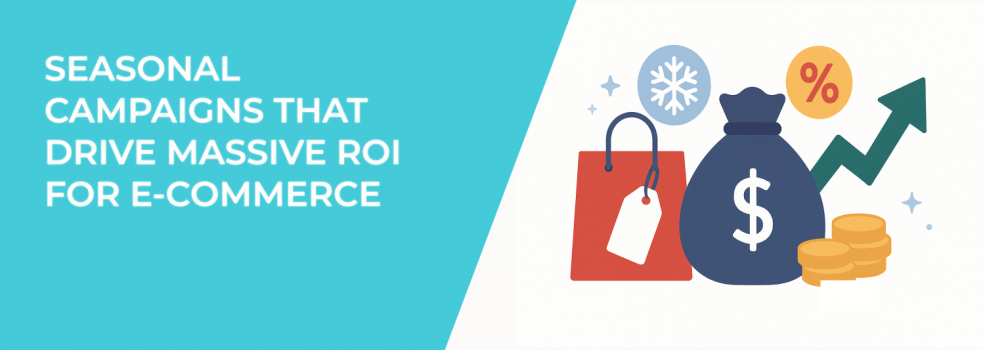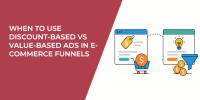Smart e-commerce marketers get this. They don’t just launch random sales when November rolls around. They prepare months in advance, building strategic, seasonal campaigns that align with shifting customer intent and high-conversion windows.
When done right, seasonal campaigns can drive some of the highest ROI of the entire year.
But how do you avoid becoming just another bland “holiday sale” ad in a crowded feed?
Let’s get into the tactics.
Why Seasonal Campaigns Work So Well in E-Commerce
Seasonal timing hits customers when they’re already primed to buy.
Here’s why seasonal campaigns convert better:
-
Built-in urgency. Whether it’s Black Friday or Valentine’s Day, buyers know the deals won’t last. This time pressure boosts conversions.
-
Emotional alignment. People are more willing to spend during moments that feel celebratory or meaningful. Your products become part of those moments.
-
Cultural relevance. Holidays and seasonal changes give you an instant angle — something to talk about that already resonates with your audience.
-
High intent traffic. Shoppers during seasonal peaks are often looking to purchase immediately, not just browse.
That’s why the best-performing e-commerce brands invest in seasonal campaigns that feel timely but also strategic. Here's how they do it.
Start Planning Earlier Than You Think
Waiting until mid-November to prep your holiday ads? You’re already behind.
Successful brands start preparing at least 60–90 days out. This allows enough time to build creative assets, plan inventory, test audiences, and refine messaging.
To get a clearer roadmap, see this guide on how to plan a 3-month Facebook Ads campaign around product seasonality. It breaks down the ideal structure for brands aiming to own the seasonal calendar.
Ask yourself:
-
When does your audience start searching for seasonal products? Hint: It’s earlier than your gut says.
-
What content and offers worked last season? Use past performance data to guide new creatives.
-
Is your team ready to scale fulfillment, support, and returns? High ad ROI means nothing if post-purchase operations break down.
Seasonal ROI doesn’t come from holiday hype alone — it comes from preparation.
Match the Offer to the Season (and the Shopper)
Not every season fits every brand — and not every shopper wants the same thing.
Use your product positioning and customer data to decide which seasonal windows are worth investing in. Then shape your offer and messaging to match the mindset of the moment.
Some high-performing seasonal angles include:
-
Back-to-school. Great for apparel, productivity tools, kids’ products, and home office gear.
-
Fall refresh. Think home decor, wellness, kitchen, and productivity — tied to routines and new beginnings.
-
Holiday gifting. Position your product as a thoughtful gift (not just another deal). Use bundles, gift cards, and limited editions.
-
New Year resets. Fitness, organization, career tools, and personal development products thrive here.
Need a more detailed seasonal approach? The article on Facebook Ads for Seasonal U.S. Retail Promotions (Fall, Winter, Holiday) is packed with ideas tailored to key retail moments.
Launch Smarter Facebook and Instagram Campaigns
Your audience expects to see seasonal ads in their feed — but how you show up matters.
To stand out and convert, follow these best practices:
-
Use dynamic product ads. Tailor promotions by user behavior and interest, not just generic offers.
-
Split creatives by audience type. New leads need education. Past buyers may just need a promo code.
-
Incorporate seasonal visuals. Winter-themed images, countdown timers, gift icons — these subtle touches improve CTR.
-
Rotate creatives every 7–10 days during peak periods to avoid ad fatigue.
-
Retarget warm audiences. Seasonal traffic brings volume. Retargeting brings profitability.
Don’t Just Choose Between Evergreen and Seasonal — Combine Them
You don’t have to shut down your evergreen campaigns during the holidays. The smartest advertisers run both — and they know when to let each one lead.
Here’s how to use both together:
-
Evergreen ads can keep your cost-per-click low during peak season when competition is high.
-
Seasonal ads spike urgency and align with short-term behavior.
-
Blend both by adding holiday touches to your evergreen messaging — like adding gift language to a high-performing ad.
Learn more in this strategy guide on how to use evergreen and seasonal ads together. It’s a must-read for brands that don’t want to lose momentum between seasons.
Think Cohesively
A truly profitable Q4 doesn’t start with Black Friday — it starts much earlier.
Many brands build seasonal momentum in late summer or early fall with teaser campaigns, lead capture ads, and light-touch brand awareness. Then, they scale with urgency and strong offers as the season progresses.
This full-funnel approach is explained in From Back-to-School to Black Friday: Building a Cohesive Fall Ad Strategy. It’s about playing the long game — not just cashing in on one weekend.
Final Takeaway
If you're serious about boosting e-commerce revenue, don’t treat seasonal campaigns as “one-offs.”
Treat them like what they are — a growth engine that repeats annually. With the right timing, messaging, and structure, your seasonal Facebook campaigns can outperform your evergreen ones without needing a huge ad budget.
And the earlier you start planning, the more profitable you’ll be.

